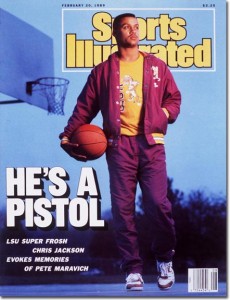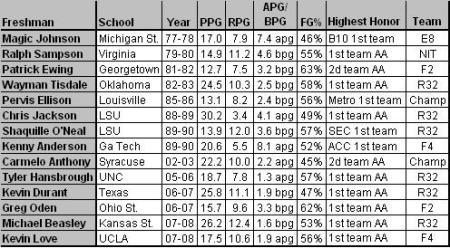
Past Imperfect is a series focusing on the history of the game. Every Thursday, RTC contributor JL Weill (@AgonicaBoss | Email) highlights some piece of historical arcana that may (or may not) be relevant to today’s college basketball landscape. This week: reliving LSU’s phenomenal Chris Jackson.
How often do you think about what’s normal in your life? Do you ever have to stop and define just what normal is or is normal the very essence of not having to define it? Is it what comes naturally, just something you do without thinking about it? Normal, for most people, is … just what is.
Culturally, we tend to make noise about the things that are not normal – on our best days, that which is better than normal; on our worst, laughing at what passes for normal for others. It’s understandable, really. Who bothers to take note of something that everyone sees as mundane, common, ordinary?
But what about those folks for whom normal is different? For those folks to whom it means not being able to do those mundane things that other people do without thinking. Or maybe it means, in certain cases, people who do things in their own way, with their own quirks, and do them fabulously.
Chris Jackson could do anything he wanted in basketball, only better than the ordinary. When you’re like Jackson, normal just isn’t part of the plan. It’s not even on the blueprints. For Jackson, normal was impossible, at least by the standards the rest of us consider, well, normal. Because no one who looks like and is Chris Jackson should have been able to do the things he could do. To this day, no one has done the things he’s already done.
But it’s not as if no one knew what he was capable of, at least in the abstract. Jackson was, after all, a two-time Mississippi High School Player of the Year, and a McDonald’s All-American, at Gulfport High. He was the jewel of legendary Louisiana State coach Dale Brown’s 1988 recruiting class. But it’s unlikely anyone, not even Brown and probably not anyone outside of Jackson himself, thought that a 6’1 string bean like Jackson was capable of dominating a college basketball game like he did for two years. If you’re just learning about it now, watching grainy clips on Youtube, it seems comical, video game-like. If you were around then to witness it, you didn’t believe it even as it was happening. The whole thing seemed, well, abnormal. Super-normal. Extra-ordinary.

Chris Jackson was already an SI cover boy during his remarkable freshman season.
Jackson arrived at LSU in the fall of 1988 a kid of circumstances. In a poor town, Jackson was raised by his single mom. Jackson never knew his father. He spent hours and hours at local courts, shooting and shooting until the shot felt perfect off his hand, off his fingertips. He practiced free throws until he didn’t miss them. He once made 283 in a row in high school. But it wasn’t just some sort of overcharged work ethic at play. Jackson was afflicted with Tourette’s syndrome, a neuropsychiatric disorder that causes tics, grunts and uncontrollable spasms and outbursts in those who possess it.
It can, and certainly did in Jackson, also manifest itself as an obsessive perfectionism, effectively convincing the brain that the afflicted cannot stop until perfection has been achieved. This means he cannot stop for exhaustion, cannot stop for dehydration, cannot stop for anything. So what made Jackson lie in bed at night shedding tears of frustration was also what helped make him into an unstoppable offensive force. It wasn’t until 1987, on the cusp of graduating to LSU, that Jackson finally got diagnosed with and got treatment for Tourette’s. Before that? He was just the weird kid that made the crazy noises and movements. He was just the kid down the street who was not normal.
Still, despite his remarkable abilities, as a small and reedy combo guard, few could have imagined how devastatingly good Jackson would be. He had always been able to score, and to shoot – thanks to natural talent and, yes, that neuro-perfectionism. But somehow, without appearing to exert much extra effort, Jackson showed up as ready for college basketball as anyone had ever been as a freshman. More ready, even. In his third game as a collegian, Jackson posted 48 points. In his fifth? 53. How about an NCAA freshman record 55 against Ole Miss? To this day, no one has ever scored more points as a freshman than Chris Jackson did in 1988-89. Not Kenny Anderson, not Jay Williams, not Kevin Durant and not John Wall. No one.
Read the rest of this entry »















































